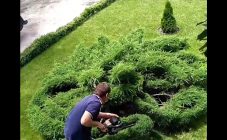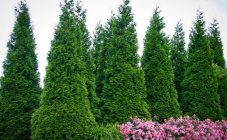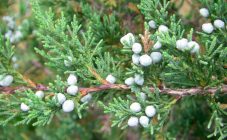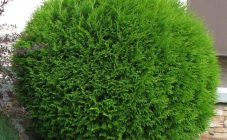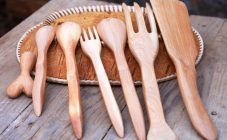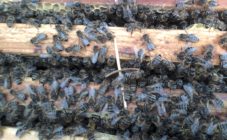Content:
The juniper gained particular popularity due to its decorativeness, variety of species and unpretentiousness. They decorate squares and flower beds, creating exquisite compositions. Many gardeners want to learn how to propagate this culture in order to decorate the site with it. It is easy to get new seedlings, because cutting junipers in summer gives excellent results.
Description and features of culture
Juniper is a coniferous shrub that grows in the forest zones of the northern hemisphere. Outwardly, its needles are similar to cypress. Bushes are tall, growing in forests, and low, located in rocks.
The culture is dioecious, divided into male and female plants. Fruits begin to give somewhere at the age of ten. They resemble peas in size and shape, are painted in blue-black color. In maturity, they acquire a bluish bloom and dense scales.
Juniper needles release phytoncides that have bactericidal properties. For a long time, the sprouts were placed in milk dishes, so the milk did not sour for a long time. Berries have the same effect, so they were always harvested and used in the economy and medicine.
There are about 70 varieties of wild-growing junipers and about 100 bred varieties. The most widespread variety in Russia is the Cossack juniper. This creeping variety is extremely decorative, at the same time unpretentious, frost-hardy and easily tolerates drought.
Junipers are especially prized for their aromatic needles and wood. The height and shape of the crown vary significantly, they can be divided into:
- conical;
- pyramidal;
- weeping;
- creeping.
It is difficult to propagate this culture by seeds, and juniper cuttings are available to any gardener.
Propagation by cuttings, in addition to its availability, has a number of other advantages:
- rooted shoots take root better;
- grow quickly and actively;
- less than seedlings react to temperature changes;
- more resistant to disease and pests;
- by the number of established shoots, cuttings are several times ahead of seedlings.
It is thanks to these qualities that juniper cuttings gained popularity.
How to propagate a juniper by cuttings
Before you start grafting a juniper, you should familiarize yourself with how to do it correctly.
As a planting material, it is best to use shoots of adult plants that are 8-10 years old. The best for grafting are undersized and ordinary varieties. You should choose symmetrical plants with a lot of branches.
Shoots are cut from the middle of the upper part of the crown; from shrub-shaped junipers, shoots are taken from the sides of the plant for reproduction. Cuttings that have already become woody should not be used.
You can grow juniper and at home. If the age of the pet growing in the house has reached 8 years old, cuttings can be taken from it for reproduction. This is done in the spring, the cutting is rooted in a mixture of peat and sand according to the same rules as the shoots of street plants.
How to prepare a cutting
Recommended length: from 10 to 15 cm, maximum length 25 cm. Cut them just before planting, the interval should not exceed 3 hours. A thickening (heel) should remain on the cut.
The needles from the bottom of the cutting are removed with a sharp knife, taking care not to damage the bark. No more than 3 - 5 branches should remain in the upper part of the shoot.
Rooting juniper cuttings in water
Many experts do not recommend rooting juniper cuttings in water due to the fact that the bark can exfoliate in the shoots placed in the liquid. But this does not always happen, sometimes juniper cuttings, placed in water, root successfully.
If the experiment is successful, then you need to prepare a mixture: 1 part of garden soil and 2 parts of zeolite. After a few days, you can stimulate the formation of roots with Kornevin, Cycron or another stimulant.
Soil preparation for germination
The rooting soil should be light, loose and hygroscopic. These are the qualities that a mixture of equal parts of sand and peat has.
So that the light soil does not dry out, the vessel with the handle is wrapped in foil.
Terms of cuttings
You can propagate a juniper by cuttings throughout the year, but spring is preferable, preferably March. At this time, a greenhouse will be required for the procedure.
How to cut juniper in summer? For successful summer rooting, you should build beds covered with foil (cold greenhouses). You can also use a greenhouse if it's not hot. The optimum temperature is 23 - 26 degrees. The soil should be slightly warmer than the air.
To plant a seedling in the fall, cut the cutting off in early summer. The planting material received in August will not have time to give roots.
Ways to stimulate rooting
How to root a juniper? You cannot do without a root formation stimulant. A solution of the stimulant in water is not very suitable for this crop, because the water can separate the bark from the water. It is better to choose Kornevin or another similar preparation in the form of a paste with which the cut is lubricated.
Further, the rooting of juniper cuttings will occur in the soil substrate. Sometimes, for insurance, a few days after planting, a liquid stimulant Heteroauxin or sodium humate is poured into the soil. The recommended dosage cannot be exceeded. Also, potash fertilizers cannot be applied during this period.
Rules for planting cuttings in the ground
How to root a juniper with cuttings? Step-by-step instruction:
- Wells are made on the surface of the substrate with a thin stick, their depth is from 4 to 5 cm.The intervals between the holes are 5 cm.
- Cuttings are carefully inserted into the wells.
- The soil is compacted around the cuttings.
- Watering should be done carefully, without wetting the bark of the cutting. Using a sprayer will not work. Re-watering will only be required if the soil dries out.
- The container with the seedlings is covered with plastic wrap with holes made for ventilation. The film is removed after two months.
Containers with seedlings are placed in a dark place. The soil in the container must be constantly moist. When planting creeping varieties, the twig is placed in the ground obliquely, then the new plant will also creep. If after two months new buds appear on the shoots, then rooting was successful.
You should not rush to transplant, because the first thin roots of a juniper from cuttings can be damaged.
Reproduction of juniper by cuttings is an effective, inexpensive and simple way. Its use allows you to obtain a new plant that has all the properties of the original specimen.



